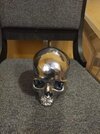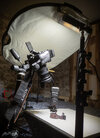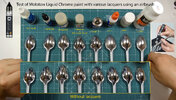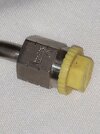First, some notes on those 2 photos for context:
- In the first photo, my bet is that head is fresh back from plating (whether you believe it was vacuum-metalized or electroplated). There doesn't seem to be any dark weathering in the recesses/details yet. I say this because you can see around the CPU port and other scribed lines don't have that deep "pop" of contrast yet.
- In the second photo, it looks like we're probably looking at the hero endoskull in the state it was in just prior to filming. The head isn't missing chunks of finish from being bashed around.
I think a lot of it may have to do with lighting and environmental conditions in the photography. How diffused and even the light is that is hitting the metallic-looking object and how much contrast is in the environment it is reflecting will have a huge impact on what the surface reflectivity is perceived to be. I know this is going to sound unpopular, but please hear me out. If you take a chrome ball and surround it with evenly lit white surfaces, it will look rather dull/matte where it is reflecting the even white environment.
For example, here's a chrome ball being shot by camera, sitting on a white surface, and surrounded on most sides by softly lit white vertical surfaces. Much of the chrome ball looks satin/matte except for the obvious reflected high-contrast area where the camera and rest of the room is clearly visible.
View attachment 1694277
That's one factor. They also still could have sprayed the metallic finish on the endo with something to dull the reflections. We know that spraying many types of clear coat over chrome dulls the finish. I'm not saying that is what they did, but it's possible. Movies often use weathering (like C3PO in Tatooine) or dulling sprays to knock down reflections (especially when they are worried about seeing themselves/the film camera in the reflection in a shot).
But, I
bet that the endoskeleton is really pretty shiny. Maybe not a perfect mirror, but nearly. Some great cinematography often involves creating more depth and separation in your shots by using lighting and atmosphere to push and pull your subject and background. Like depth of field (DOF-focus), it's a huge tool in a cinematographers toolkit, and I know James Cameron pumped something into the air in many shots at the end of The Terminator. The factory background is often foggy looking behind the endoskeleton (and probably all around it too). Look at the difference in black point between the shadows on the endoskeleton, and the shadows on the factory walls/ceiling. I believe that this is having an effect on how light is traveling to the endoskeleton metallic finish, and also that the environment it is reflecting is hazy in many of the shots. Also note that as I've examined lighting choices in the final sequences of T1, it seemed like to make the endoskeleton more scary/sinister, it's rarely lit from the front and often we get glancing lighting from the sides. I think this keeps much of the face in darkness which also doesn't reflect a lot. Like this example:
View attachment 1694269
The reason I'm not sure if they used any intention dulling (other than the metallic finish getting abused and roughed up/chipped up over the course of filming), is there are shots in the film where you can see really sharp and strong reflections. I'll post this example toward the endo of The Terminator where the endoskull looks nearly as chrome as the Icons replica. Look in particular around the nose/cheek/chin area. That's a chrome-like reflection in my book:
View attachment 1694255
Ok, sorry for the long post. But it's a complex topic for sure. And again, I'm not saying I have a definitive answer, but everything I see can be explained by how light, environment, atmosphere, and reflectivity work. Also, there's behind the scenes gems like this photo I'll just drop right here:
View attachment 1694276
Discuss,
-Dana





